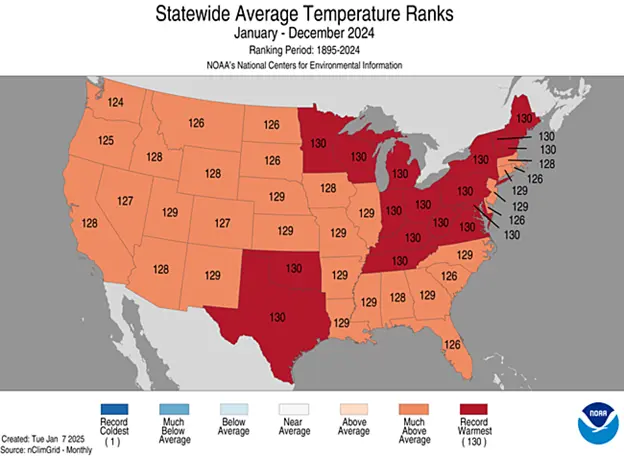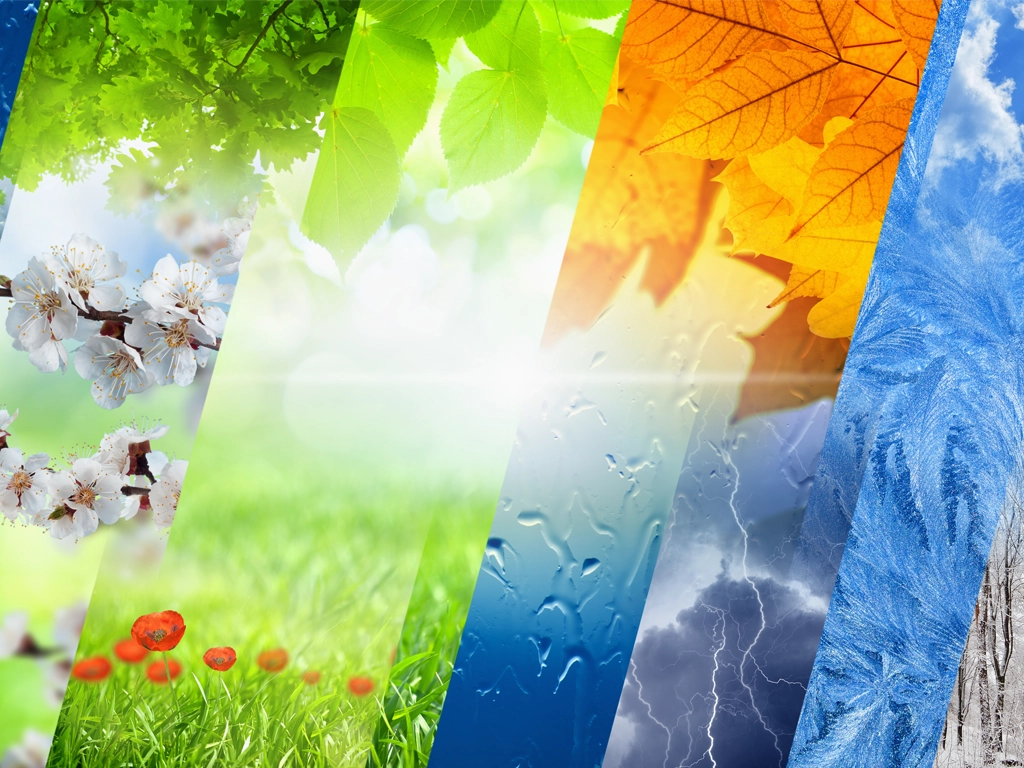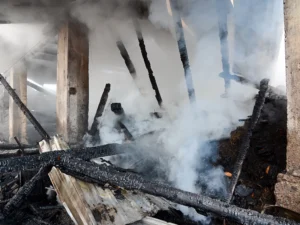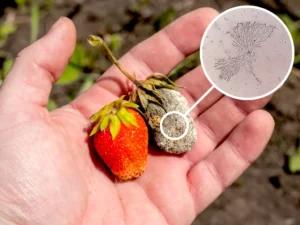Spring has sprung! Flowers are blooming! Birds are singing! Molds are sporing?! Wildfires are raging!?!? Hmmm, perhaps it’s once again time to dig into the National Oceanic and Atmospheric Administration’s (NOAA’s) weather predictions and anticipate how they may affect air quality. Here’s what you’ll see in your climate region over the next 12 months.
Grading Last Year’s Predictions
Last year, we predicted warmer temperatures overall and a bumper crop of wildfires. We were spot-on. Per a report by the National Interagency Coordination Center, “In 2024, there were 64,897 wildfires that burned 8,924,884 acres. The total number of fires and acres burned were both above the [5] and 10-year averages.”
It was also the hottest year on record in Oklahoma and Texas, and in the top 5 hottest years for everyone else.

Image Credit: NOAA
As for precipitation, we predicted a complex picture leaning towards dry. The picture was indeed complex…but more so than we expected. Montana, Wyoming, and Arizona did have dry years, but California, Texas, and Colorado were wetter than average. Thus, this year, we shall err on the side of caution with our predictions of drought out west.
South Climate Region (AR, KS, LA, MS, OK, & TX)
Last year, we didn’t predict how complex the temperature would be in the summer, nor that January would see a brief cold snap. Our predicted dry spell for Mississippi came a few months late, and the overall precipitation had more extreme and rapid variations than we expected. Most of these, however, are specific variations bound to occur in the conflux between foresight and reality; our overall picture remained correct. Let’s see what’s in store for ActivePure’s home region this year.
| Last Year’s Prediction | Last Year Actual | NOAA's Prediction This Year | Our Prediction This Year | |
|---|---|---|---|---|
Summer | Warm | Varied | Varied | Varied | Warm | Varied | Warm | Varied |
Fall | Warm | Varied | Warm | Varied | Warm | Varied | Warm | Varied |
Winter | Varied | Varied | Varied | Varied | Varied | Varied | Varied | Varied |
Temperature
Up until December, the region will be contested between a 33-40% chance of greater temperature in the north and a 40-50% chance of greater temperature to the south. Around August, a 50-60% chance of above-average temperature will hug the Gulf. Kansas and some nearby regions of Arkansas and Oklahoma can expect normal winter temperatures.
Precipitation
NOAA predicts Kansas and Oklahoma will be rather dry until October, with their spell of bad luck occasionally expanding into Texas and Arkansas. Coastal Mississippi and the area around New Orleans might get a bit damper than the mean in late summer and/or early fall, while it will be drier than average around late fall and early winter. Anywhere west of the Pecos River in Texas should also expect a dry spell this winter.
Air Quality
Keep an eye out for the following weather-induced air quality problems this year:
- Ground-Level Ozone: A hot and dry summer in Kansas and Oklahoma may lead to the accumulation of ground-level ozone in urban areas. This pollutant is associated with everything from asthma to mental health emergencies.
- Pollen: Expect a long allergy season, especially for tree pollen, as warmer temperatures cause trees to start releasing pollen earlier and stop later. That being said, a longer season can also drive the daily pollen count down.
- Mold: The coasts of MS and LA might want to invest in dehumidifiers for their basements, if they haven’t already. Otherwise, August rain could lead to December mold.
- Wildfire Smoke: Expect sporadic wildfires throughout the year.
Southwest Climate Region (AZ, CO, NM, & UT)
Last year’s predictions were nearly perfect, especially regarding Arizona’s long dry spell and northeast Colorado’s average summer. Our main oversight was not predicting average November temperatures and a cooler January. This year, the Four Corners states can also expect a hot year with chaotic precipitation.
| Last Year’s Prediction | Last Year Actual | NOAA's Prediction This Year | Our Prediction This Year | |
|---|---|---|---|---|
Summer | Warm | Varied | Warm | Varied | Warm | Wet | Warm | Wet |
Fall | Warm | Varied | Varied | Varied | Warm | Average | Warm | Average |
Winter | Varied | Varied | Varied | Varied | Varied | Dry | Varied | Dry |
Temperature
It is going to be a warmer-than-average spring and a dang hot summer across the region. Sometimes the heat wave will be centered on the region itself, and sometimes it will expand from the Pacific states. Around January, northern Utah and Colorado will return to mean temperatures for a time. By April 2026, even Northeast Colorado will shoot to above-average temperatures.
Precipitation
Expect a dry spell across the whole region until early June. Then things get interesting. An area centered around Cochise County, AZ and Hidalgo County, NM will experience a 33-50% chance of greater-than-average precipitation. This area will bloom and cover almost the entirety of both states by August, then slowly recede in September. January through March, the same geographic pattern will happen again, but this time with a 33-50% chance of lower-than-average precipitation.
As for Colorado and Utah, they will remain mostly average from summer onward, except for the Great Salt Lake area in Utah and Moffat County, Colorado, which are at greater risk of drought until Fall.
Air Quality
Keep an eye out for the following weather-induced air quality problems this year:
- Airborne Pathogens: A hot summer with occasional precipitation will drive people inside, possibly leading to a spike in respiratory disease during this time.
- Wildfire Smoke: This region will have to deal with wildfires, as it always does. We predict, however, that this year it may have slightly fewer.
- Pollen: A hot summer with above-average precipitation means that pollinating plants will have a field day (pun intended). Expect a particularly punishing fall allergy season.
- Temperature Inversion: A temperature inversion is a cap of stagnant, cold air that can lock in pollution (such as particulate matter and VOC gases) over a winter city. This region, with its many cities abutting mountains, is particularly vulnerable to this phenomenon.
- Ground-Level Ozone: Though a wetter summer than average may mean less ground-level ozone this year, the region’s baseline climate means that it will still have to watch ozone levels.
West Climate Region (CA & NV)
Last year, we were correct to predict a drought centered on Fort Yuma starting in Autumn. We were also correct in predicting above-average temperatures, especially in northern latitudes (albeit they lasted longer than we thought). Winter and autumn, however, were warmer than we predicted.
| Last Year’s Prediction | Last Year Actual | NOAA's Prediction This Year | Our Prediction This Year | |
|---|---|---|---|---|
Summer | Warm | Average | Warm | Varied | Warm | Dry | Warm | Varied |
Fall | Average | Varied | Varied | Varied | Warm | Average | Warm | Average |
Winter | Average | Varied | Warm | Varied | Varied | Average | Varied | Average |
Temperature
Overall, it will be hotter than the mean, but the inland/southern regions have a greater chance of an increase than the coastal/northern regions. The exception is that northern California and northern Nevada will likely have an average winter.
Precipitation
This region can expect a dry spring/early summer in 2025 and then an average year afterwards. Expect a few lingering droughts at the fringes of the region.
Air Quality
Keep an eye out for the following weather-induced air quality problems this year:
- Ground-Level Ozone: A hot summer leaning towards dry may cause ground-level ozone to build up in urban areas.
- Wildfire Smoke: Average precipitation isn’t good enough for this rather fire-prone region. Denizens of CA and NV will have to put up with the usual infernos this year.
- Temperature Inversion: This region — with many of its cities nestled in mountain valleys — is particularly vulnerable to temperature inversions, though likely only in the northern counties.
Overall Air Quality Prescription
These 3 regions will experience a wide variety of air quality problems this year. To help you pick the best solution(s) for you, we’ve created the following handy chart.
Sealing/ERV/Smart-Monitoring Combo | ||||
|---|---|---|---|---|
Mold Spores | Good | Better | Good | Best |
Pollen | Particulate Matter | Wildfire Smoke | Good | Better | Best | n/a |
Airborne Pathogens | Good | Best | n/a | Includes ActivePure Devices |
VOC Gases | n/a | Best | Good | Includes ActivePure Devices |
Ground-Level Ozone | n/a | n/a | Best | n/a |
Curious about any of these solutions? Contact us today to learn what we can do to protect your home. If you’re looking for a quick and affordable way to protect your indoor spaces, we’ve recently partnered with Allergy Buyers Club to offer our ActivePure Surface & Air Guardian for direct purchase for the first time ever. This four-in-one product combines ActivePure Technology, HEPA, ionization, and carbon to maximize the number of contaminants it works against.



